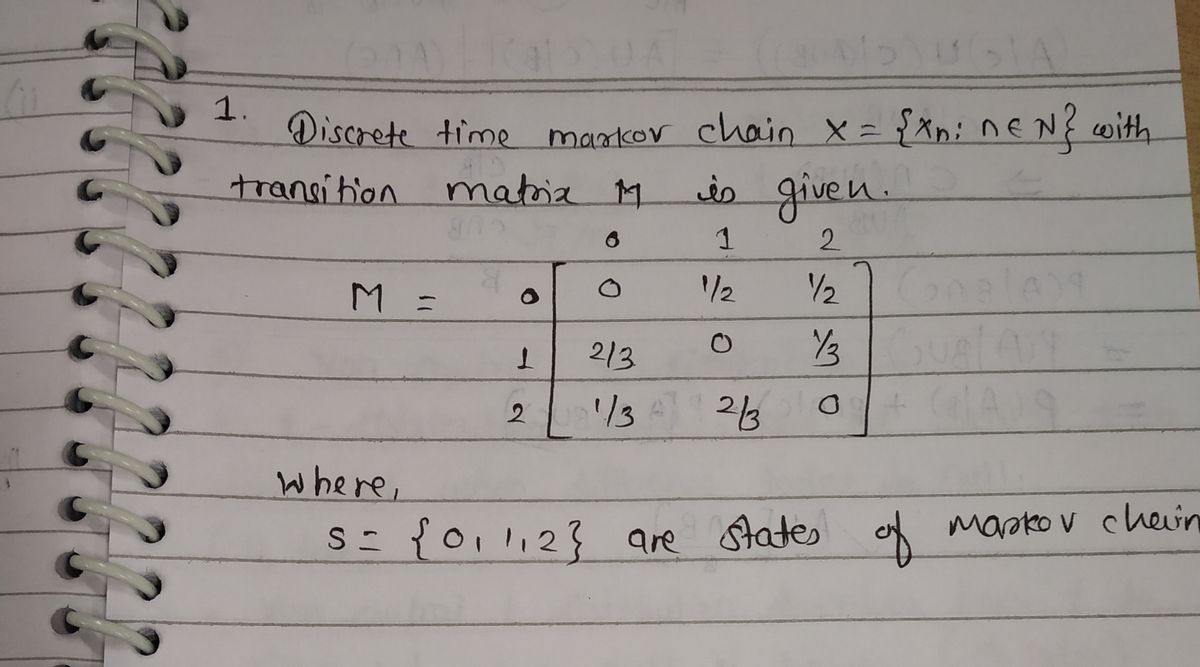1. (a) Consider a discrete-time Markov chain X = {X₂: ne N} with a transition matrix 0 1/2 1/2 M = 2/3 0 1/3 1/3 2/3 0 i. Draw the transition diagram of X. ii. Specify the period of each state - you are welcome to use R. Is the Markov chain irreducible, positive recurrent and ergodic? Justify your arguments. iii. Determine the stationary distribution of X from the equation лP = 1.
1. (a) Consider a discrete-time Markov chain X = {X₂: ne N} with a transition matrix 0 1/2 1/2 M = 2/3 0 1/3 1/3 2/3 0 i. Draw the transition diagram of X. ii. Specify the period of each state - you are welcome to use R. Is the Markov chain irreducible, positive recurrent and ergodic? Justify your arguments. iii. Determine the stationary distribution of X from the equation лP = 1.
MATLAB: An Introduction with Applications
6th Edition
ISBN:9781119256830
Author:Amos Gilat
Publisher:Amos Gilat
Chapter1: Starting With Matlab
Section: Chapter Questions
Problem 1P
Related questions
Question
I need this question completed in 5 minutes with handwritten working

Transcribed Image Text:1. (a) Consider a discrete-time Markov chain X = {Xn : n E N} with a transition matrix
M =
0 1/2 1/2
2/3 0 1/3
1/3 2/3 0
i. Draw the transition diagram of X.
ii. Specify the period of each state - you are welcome to use R. Is the Markov chain
irreducible, positive recurrent and ergodic? Justify your arguments.
iii. Determine the stationary distribution of X from the equation лP = π.
π
(b) Let X = {X, : t≥ 0} be a time-homogeneous Markov process with state-space S = {1, 2, 3}.
The average time X spends in each state 1, 2 and 3 is given respectively by 1/2, 1/3 and
1/6 unit of time. The probability P(XT j|Xo = i) of making an immediate jump from
state i to state j, with (i, j) € S, is given by the matrix M (1) in the question 1(a) above.
Note that T refers to the jump time of the Markov process.
i. Show that the corresponding intensity matrix Q of the Markov process is
Q =
=
-2 1 1
2
2 4 -6
!).
-3 1
ii. Find the average time it takes the process to move from state 1 to state 3.
Expert Solution
Step 1: Given

Step by step
Solved in 7 steps with 6 images

Recommended textbooks for you

MATLAB: An Introduction with Applications
Statistics
ISBN:
9781119256830
Author:
Amos Gilat
Publisher:
John Wiley & Sons Inc

Probability and Statistics for Engineering and th…
Statistics
ISBN:
9781305251809
Author:
Jay L. Devore
Publisher:
Cengage Learning

Statistics for The Behavioral Sciences (MindTap C…
Statistics
ISBN:
9781305504912
Author:
Frederick J Gravetter, Larry B. Wallnau
Publisher:
Cengage Learning

MATLAB: An Introduction with Applications
Statistics
ISBN:
9781119256830
Author:
Amos Gilat
Publisher:
John Wiley & Sons Inc

Probability and Statistics for Engineering and th…
Statistics
ISBN:
9781305251809
Author:
Jay L. Devore
Publisher:
Cengage Learning

Statistics for The Behavioral Sciences (MindTap C…
Statistics
ISBN:
9781305504912
Author:
Frederick J Gravetter, Larry B. Wallnau
Publisher:
Cengage Learning

Elementary Statistics: Picturing the World (7th E…
Statistics
ISBN:
9780134683416
Author:
Ron Larson, Betsy Farber
Publisher:
PEARSON

The Basic Practice of Statistics
Statistics
ISBN:
9781319042578
Author:
David S. Moore, William I. Notz, Michael A. Fligner
Publisher:
W. H. Freeman

Introduction to the Practice of Statistics
Statistics
ISBN:
9781319013387
Author:
David S. Moore, George P. McCabe, Bruce A. Craig
Publisher:
W. H. Freeman